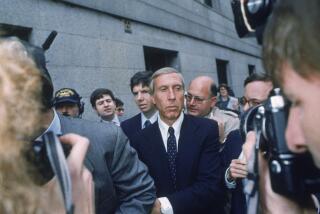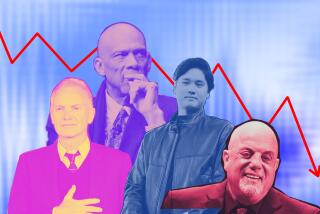Howls, hoots on N.Y. trading floors over ‘Wolf of Wall Street’ excess
NEW YORK — Veteran stock trader Alan Valdes remembers the excesses of Wall Street during the 1990s: fat paychecks, drugs after hours and lavish spending on flashy cars.
“The Wolf of Wall Street,” Martin Scorsese’s new portrayal of the notorious fraudster Jordan Belfort and his downfall, seems to capture the industry’s wilder days, but not without Hollywood’s own embellishment, Valdes said.
“It was over-the-top,” said Valdes, who enjoyed the flick with his girlfriend at a nearly empty Manhattan theater as a snowstorm bore down on the East Coast last week. “I knew guys like that, but not that bad — that’s for sure.”
PHOTOS: Movie scenes from ‘The Wolf of Wall Street’
Anyone who has seen Scorsese’s cinematic portrayal of the financial industry has endured three hours of beautifully shot scenes of Long Island hucksters bilking investors, frolicking with women in the office and snorting piles of cocaine.
Those who work on Manhattan’s trading floors and in its gilded skyscrapers have variously been amused, entertained and sent groaning by “The Wolf of Wall Street” since its debut on Christmas Day.
But Stratton Oakmont, Belfort’s company, was a particular breed of Wall Street animal. The company specialized in hawking penny stocks, or low-priced shares of financially suspect businesses, to unsophisticated investors. Or as Belfort, played by Leonardo DiCaprio, describes it on-screen, the job entailed “selling garbage to garbage men.”
In Wall Street parlance, Belfort’s operation was a boiler room or a bucket shop — and a far cry from major investment banks or trading shops headquartered in New York’s financial district or Midtown Manhattan.
“It was a great depiction of bucket shops when bucket shops prevailed,” said Jason Weisberg, managing director at Seaport Securities and an avid Scorsese fan who saw the movie the day it opened.
PHOTOS: Best films of 2013 | Betsy Sharkey
And Stratton Oakmont was particularly known for its own brazen hedonism.
Peter Costa, president of Empire Executions, hasn’t yet seen the movie but knows a former Stratton Oakmont employee who vouched for the movie’s accuracy.
“He said those guys were out of control,” Costa said.
The real-life Stratton Oakmont’s excesses were documented by Gregory Coleman, the FBI agent who brought down Belfort and is portrayed by Kyle Chandler in the movie.
Most of the company’s shenanigans apparently occurred outside its offices, such as when buses ferrying brokers picked up hookers on the way to Atlantic City, Coleman said.
“There were things that went on, of course, in the bathrooms and the elevators and sometimes in the boardroom, but most of it would occur during gambling junkets or at parties,” said Coleman, who works out of the FBI’s New York office. “The bachelor parties were really where it got extremely excessive.”
Stratton Oakmont was also based on Long Island, making the film’s title something of a misnomer in the eyes of purists. The term “Wall Street” is more commonly associated with the financial titans of Manhattan — Goldman Sachs, JPMorgan Chase & Co. and the like — where the culture is decidedly straight-laced and buttoned-down.
PHOTOS: Best films of 2013 | Kenneth Turan
“It’s not a world that’s familiar to most people on what you would call ‘Wall Street,’” said one New York City hedge fund manager who saw the movie with his wife over the holidays and who declined to be quoted publicly on the subjects of drugs, sex and financial fraud.
“I never had parties at my hedge fund, and I was thinking as I was watching the movie, ‘God, I’ve missed a lot!’”
To be sure, no one is saying that drug use has disappeared on Wall Street. But relative newcomers to finance also see little in common with the film’s depiction of their industry.
One 29-year-old Wall Streeter who specializes in computer-driven trading said the closest he’s encountered to such excess came when he was based in China.
About five years ago, a business associate flew from Australia to Hong Kong to meet him for dinner, said the trader, who declined to be identified because of his firm’s policy against talking with the media. They later flew via helicopter to a private island for an expensive meal.
“It wasn’t like all-night partying with drugs,” said the trader, who went to the movie with a date and found it entertaining.
Christopher Mroz, who spent three years as an investment banker at JPMorgan but now is a day trader, found the movie amusing, a bit long and decidedly sensationalistic.
“A lot of people want to think Wall Street is like that,” said Mroz, 32. “But I think in reality it’s a lot of nerdy guys with calculators working all night.”
Many said they wouldn’t be surprised if the lawless, rip-off-investors-to-get-rich atmosphere in the movie further inflamed public ire against the financial industry.
“The Wolf of Wall Street” comes as the sector finds itself embattled.
The FBI and federal prosecutors in Manhattan have been aggressively taking down Wall Streeters who cheat by trading on inside information unavailable to the general public.
And five years after the financial crisis, Wall Street is still weathering assaults by regulators and prosecutors seeking payback for the housing collapse and Great Recession.
“Throw gasoline on the fire — that’s how you build ticket sales,” Weisberg said. “It’s genius. It was very clever. I don’t begrudge them that, I applaud the timing.”
There are of course many on Wall Street who have yet to see the movie — and some who have no interest.
PHOTOS: Behind the scenes of movies and TV
Timothy Connolly, who runs the hedge fund Sconset Capital Management, said he wasn’t comfortable with seeing a movie that seems to glorify criminals.
“I make a living not being the way they were,” Connolly said. “They make it harder for us to make an honest living on Wall Street.”
Veteran trader Art Cashin, a managing director at UBS, hasn’t seen the movie either. He scoffed at the likes of Belfort and others depicted in the movie, dismissing them as “low lifes.”
“There’s no rush” to see the film, said Cashin as he nursed a glass of Scotch at a bar across from the New York Stock Exchange one recent evening.
Besides, he added: “Three hours goes far beyond Wall Street’s attention span.”
More to Read
Inside the business of entertainment
The Wide Shot brings you news, analysis and insights on everything from streaming wars to production — and what it all means for the future.
You may occasionally receive promotional content from the Los Angeles Times.










